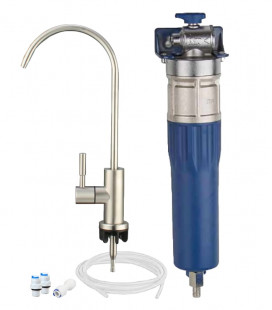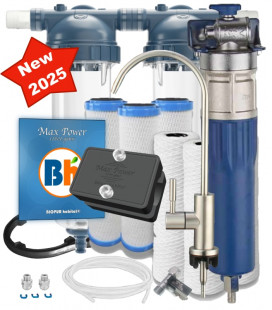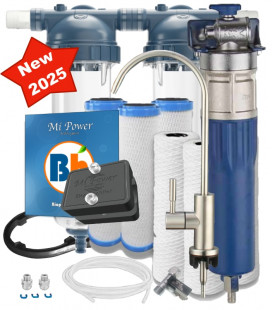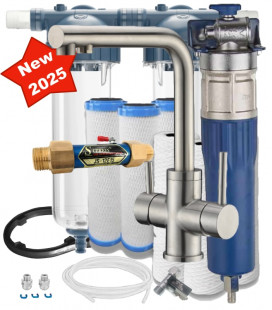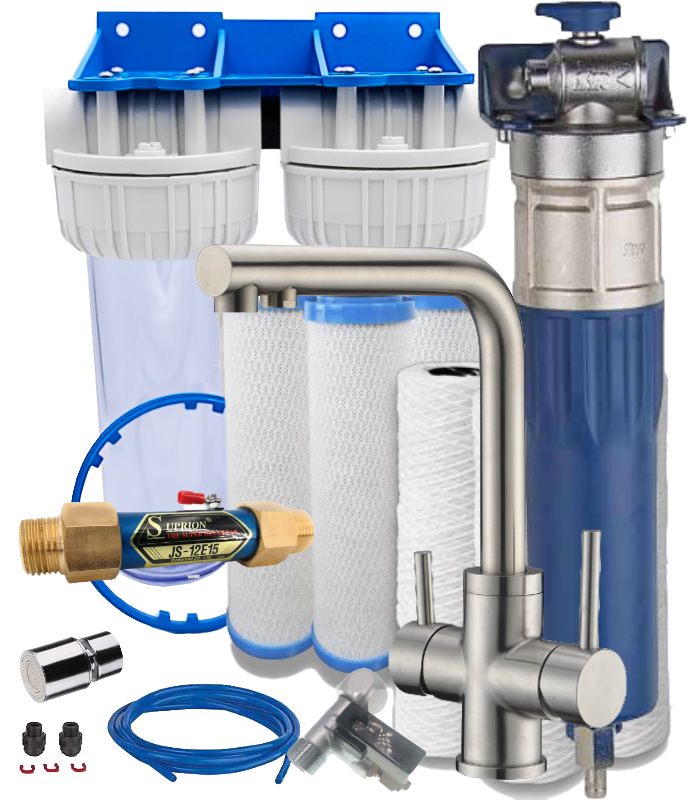No products
Prices are tax included

Tap water a health hazard?
A whole song: aluminum salts, pesticides and what else... no comment ?
In France there are a lot of controls on tap water but do we completely control its distribution and quality?
Many factors tend to say that it is more complicated than it seems.
Water has an interesting physical property, it is a very good solvent and can be mixed with many materials. Great you may say, to make pancake batter or a good syrup for your children but unfortunately given the importance of all the water-soluble elements that exist, it is very difficult to control everything without concretely targeting what you are looking for.
It is clear that we cannot analyse all the products that could be found in the water as they are so numerous, but we know today that for commercial reasons we use, for example, aluminium salts to clarify the water, chlorine to destroy bacteria, but we will also find products whose future damage to health is still being minimised, such as drug residues, for example.
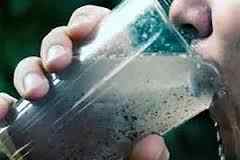
These are the results of the magazine's analysis of water tests carried out between July 2011 and January 2014 on 36,568 French women (published on the French Ministry of Health's website
I've made a few suggestions in blue on the important points
While about 50 regulatory criteria are usually controlled by official services (there are more than 600 if non-mandatory criteria are added), for the purposes of this study, we have selected the criteria that are most representative of the non-conformities usually encountered, as well as criteria that are relevant to food safety and consumer concerns. On this basis, we selected six parameters covering three types of contamination.
1 - Pollution due to a malfunction of the sanitation treatment
These contaminations are more frequently encountered in rural or mountain communities and may be due to outdated water treatment and distribution facilities or a lack of monitoring. Isn't it time for the budget given to the private sector to be allocated directly to the municipalities?

- Bacteriological quality: this is the primary requirement for water to be considered potable. On the one hand, we have retained coliform bacteria which, without necessarily being pathogenic, cover a wide spectrum of bacteria encountered as soon as a failure occurs. On the other hand, we noted the results for Escherichia coli and enterococci, which are likely to cause health problems.
- Aluminium content: the presence of aluminium can be of natural origin, but most often it results from the voluntary addition of aluminium salts used to make naturally turbid waters clear. (watch the video about alzheimer's disease)
2 - Pollution from our agriculture in 2016
Agricultural pollution alone accounts for the majority of pollution found in drinking water.
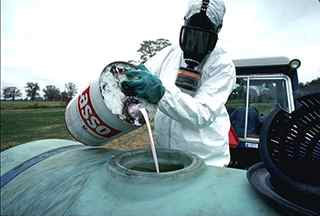
- Nitrates: resulting from the application of fertilizers and animal manure to crops, they are the primary cause of the closure of drinking water catchments.
- Pesticides: we checked the conformity of water on two types of criteria. On the one hand, on the maximum content allowed for all pesticides combined, and on the other hand, on the maximum content of atrazine (this pesticide, although it is now banned, persists for a very long time in the environment, which explains why it is the most frequently detected molecule).
- Selenium: this component naturally present in the deepest layers of the soil appears in particular when overexploitation of the water table requires deep drilling.
Like most trace elements, selenium plays a key role in the body as a whole. Intracellularly, it has an antioxidant effect, as it enables the body to produce glutathione peroxidase. This enzyme works in conjunction with vitamin E to protect cell membranes from oxidation caused by free radicals. In excess, free radicals cause premature aging and are believed to contribute to the development of certain types of cancer, cardiovascular disease and cataracts. Selenium also plays an essential role in the functioning of the immune system and the thyroid gland.
Here we see that it is above all our civilization and the outdated techniques used by lobbies to make money that are the problem. Industrial powers such as Monsanto or Bayer, which are much talked about at the moment, for example, are not about to weaken and it is better to count on personal action to protect ourselves than to wait for our government to act!!!
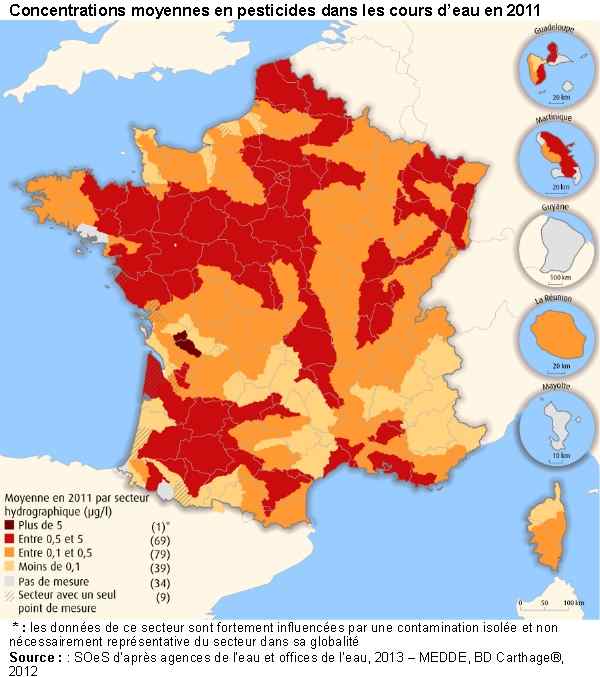
3 – Des pollutions naturelles de la ressource
- Radioactivity: the radioactivity encountered in water is very generally of natural origin. It is due to the presence, in certain regions, of a granitic subsoil rich in radioactive compounds. We have chosen the parameter "indicative total dose" which reflects the total radioactivity for all the radioactive elements likely to be present. More and more people are talking about the problem of RADON, a gas that comes naturally from the ground and ends up in our homes.
Maximum limits for each pollutant :
- Atrazine and its metabolites: ≤ 0.1 µg/l (1)
- Total pesticides analysed: ≤ 0.5 µg/l (1)
- Bacteriological criteria (coliform bacteria (2), Escherichia coli (1), enterococci (1)): absent in 100 ml
- Nitrates: ≤ 50 mg/l (1)
- Radioactivity (indicative total dose): ≤ 0.1 mSv/year (2)
- Aluminium: ≤ 200 µg/l (2)
- Selenium: ≤ 10 µg/l (1)
Who set these rates and can we be sure there are no risks? I'm always afraid of laboratories or researchers that are indirectly funded by good and loyal donors...
Risques par polluant
- Nitrates
Excessive levels of nitrates in the diet can put infants at risk of methemoglobinemia (blue baby syndrome). This is because nitrates, which are converted in the body to nitrites, can, by altering the haemoglobin properties of the blood, prevent the proper transport of oxygen by red blood cells. However, no case of methaemoglobinaemia linked to drinking water has been recorded today in France. More generally, the presence of nitrates in drinking water is an indicator of pollution of agricultural origin, which may be accompanied by the presence of other pollutants such as pesticides. - Pesticides
The risk posed by pesticides is that of long-term exposure, at very low but repetitive doses, with possible interactions between different pesticides. Suspected risks, which have not been demonstrated to date, could include cancers (leukaemia in particular), nervous system disorders and reproductive disorders. Still no demonstration to date on the impact of pesticides on the environment!!!(we have the right to wonder if there is not a problem so that nothing and nobody can finally respond firmly and act on this vital problem for our civilization!!!) - Selenium
It is a component of deep rocks whose presence in the water indicates the depletion of the resource. Although this compound is toxic, its health consequences are currently poorly assessed given the low levels to which the French population is exposed. - Bacteriological quality
Defects in drinking water treatment (chlorination) or damaged pipes in the network can lead to the presence of bacteria responsible for example for intestinal disorders. That's why it would be better to treat the water downstream rather than upstream!!!! - Aluminium
Aluminium is used in the form of salts to make naturally cloudy water clear. Although to date there is no demonstrated link between exposure to aluminium and Alzheimer's disease, applying the precautionary principle, it is recommended to limit the doses ingested.. (there are no studies that prove the contrary!!!) - Radioactivity
The radioactivity of the water is due to the presence, in some regions, of a granitic subsoil rich in radioactive compounds naturally present in the rocks. It is low compared to other sources of natural radiation (radiation from the subsoil, ambient air or cosmic radiation). Epidemiological studies conducted to date have not established a link between drinking water and cancers of the digestive system or other organs. However, applying the precautionary principle, it is recommended that such contamination be limited.
Les (so to speak) bons gestes pour le consommateur
We're told to let it run a little while before drinking it. In case of a strong smell, it would be sufficient to let the water aerate in an open container (there are harmful products in the water that cannot be detected by taste or smell...).
We are told that when the nitrate concentration is between 50 and 100 mg/l, the water should not be consumed by pregnant women and infants. We are also told that if it is 100 mg/l or more, the water should not be used for food purposes. How to control water every time it is used!!!!
The solution to avoid all risks and not depend on anyone else is to use filtration systems to treat water.
(1 ) These criteria are defined by the regulations as quality limits, i.e. parameters for which exceedances are likely to result in immediate or longer-term health effects.
(2) From a regulatory point of view, these criteria are quality benchmarks that do not directly affect health at the levels usually observed in water, but which may cause discomfort or inconvenience to the consumer.
So is the tap water dangerous or not?
My conclusions: we must not lose sight of the fact that water management is entrusted to private companies and that they must generate profits. There is not enough control (50 mandatory!!!) and the limits set for polluting products in water alone remain arbitrary. There are more and more new and auto-immune diseases (3rd most common disease after cancer and cardio vascular problems...) and we have no control over the quantities of such and such pollutants that the organism can tolerate. Homeopathy, which took a long time to be recognized, is the very example of the action that certain products can have on the body while very small quantities are absorbed.
In all the risks that we have been able to evoke previously and officially listed by state organisms, we are told of potential dangers, probabilities, unrealized demonstrations... in short, we do not move forward and we are faced with a laxity that suits those who gorge themselves or are satisfied with this catastrophic situation. Decisions should be taken and firmly applied in order to put an end once and for all to a dangerous situation for all and which should no longer continue.
It is also imagined that there are bound to be new products on the market that will replace the old ones and infiltrate our water tables again without us yet knowing their effects or even their existence:
- For example, we control atrazine, even though it's a banned pesticide, but what has replaced it? It would not be surprising if new products were used without yet having been revealed as dangerous to health. Companies that manage phenomenal budgets such as that of water will first look for ways to deal with the problems they encounter before finding real solutions (a budget that costs but does not pay off). It's all about business!!!
Personally, I will opt for the precautionary principle and prefer not to leave my health in the hands of those who do not want us to disrupt their operations and hide behind statistics and controls that suit them see that they themselves have defined as any good lobby that respects itself ...
The flow of greenbacks for some mobilizes more than the flow of clean water for all...
Leave a CommentLeave a Reply
Blog archives
Blog categories
Latest Comments
Biopur habitat
on Softener and anti-scale Part 2, co2 softenerBiopur habitat
on Water Softener and Limescale Remover Part 3,...Biopur habitat
on Which water filter pitcher, osmosis or water...

